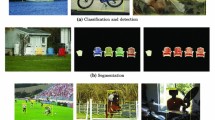Abstract
A skeleton is a global shape descriptor that aims to characterize the general appearance of an object to facilitate object classification. Various ways for defining the skeleton of a polygon have been proposed in the literature. Yet, in some cases, these previously proposed skeletons may not intuitively resemble the original polygons and cannot be a good shape descriptor. This research proposes a new definition of skeletons for modeling polygons. The proposed skeleton is termed the area-trimmed (A-trimmed) skeleton. In modeling the global shape of polygons, the A-trimmed skeleton performs much better than other skeletons proposed in the literature. The A-trimmed skeleton can be applied in group technology and facilitate tasks such as punched-part design and fixture design.
Similar content being viewed by others
References
Wu MC, Jen SR (1996) A neural network approach to the classification of 3D prismatic parts. Int J Adv Manuf Technol 11:325–335
Cheok BT, Zhang YF, Leow LF (1997) A skeleton-retrieving approach for the recognition of punched parts. Comput Ind 32:249–259
Wu MC, Yen JY (1992) A skeleton-retrieving technique for aiding modular fixtures design. Int J Adv Manuf Technol 8:123–128
Blum H (1967) A transformation for extracting new descriptors of shape. In: Whaten-Dunn W (ed) Models for the perception of speech and vision form. MIT Press, Cambridge, pp 362–380
Blum H, Nagel RN (1978) Shape description using weighted symmetric axis features. Patt Recogn 10:167–180
Montanari, U (1968) A method for obtaining skeletons using a quasi-Euclidean distance. J ACM 15:600–624
Preparata FP (1977) The media axis of a simple polygon. In: Proceeding of 6th Symposium on Mathematical Foundations of Computer Science, pp 443–450
Lee DT (1982) Medial axis transformation of a planar shape. IEEE Trans Patt Anal Mach Intell 4:363–369
Bookstein FL (1979) The line-skeleton. Comput Graph Image Process 11:1223–1237
Wu MC, Chen JR (1994) A skeleton approach to modeling 2D workpieces. J Des Manuf 4:229–243
Wu MC, Chen JR, Jen SR (1994) Global shape information modeling and classification of 2D workpieces. Int J Comput Integr Manuf 7:261–275
Sherbrooke EC, Patrikalakis NM, Brisson E (1995) Computation of the medial axis transform of 3-D polyhedra. IEEE Trans Vis Comput Graph 2:62–72
Author information
Authors and Affiliations
Corresponding author
Rights and permissions
About this article
Cite this article
Wu, MC., Chen, JR. & Chuang, JH. An A-trimmed skeleton for modeling the global shape of polygons. Int J Adv Manuf Technol 27, 1140–1147 (2006). https://doi.org/10.1007/s00170-004-2308-z
Received:
Accepted:
Published:
Issue Date:
DOI: https://doi.org/10.1007/s00170-004-2308-z




